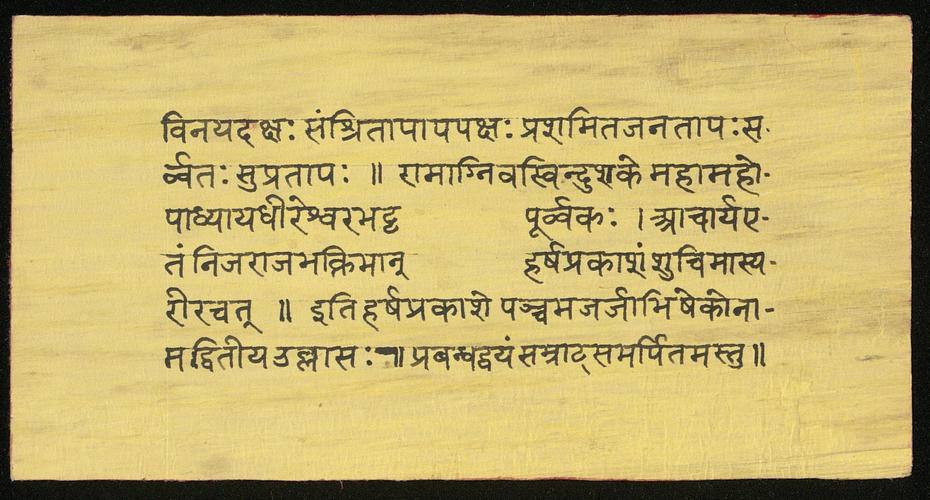-
1 of 253523 objects
शोक प्रकाश - हर्ष प्रकाश Shoka Prakasa-Harsha Prakasa (Lamentation and Jubilation) c. 1911-3
ink on palm leaf | 8 x 15.2 x 2.3 cm (whole object) | RCIN 1005012

Mahamahopadhyaya Dhireswar Bhattacharyya
Master: शोक प्रकाश - हर्ष प्रकाश Shoka Prakasa-Harsha Prakasa (Lamentation and Jubilation) Item: Harsa prakasa = Jubilation c. 1911-3

-
Sanskrit verses written on palm leaf lamenting the death of King Edward VII and celebrating the accession of King George V, presented to him by the author, a Sanskrit scholar from Assam. He composed the poems at the time of King George V’s Coronation in 1911.
In the Shoka Prakasa (‘Lamentation’) the writer bewails the death of King Edward VII and commiserates with the people of India and the widowed Queen (Alexandra), for whose consolation he prays. He then extols the new King George V and ‘lays before him these verses’. The second poem, Harsha Prakasa (‘Jubilation’), is a prayer for the long life of King George V and an expression of the ‘joy of the Indian peoples’ at His Majesty’s visit to India together with his Royal Consort (Queen Mary), upon whom all blessings are evoked at the time of their Coronation. The poem concludes with a dedication of both poems to His Majesty.
The manuscript (known as a puthi, in Bengal) is a small gathering of palm leaves held between two wooden boards. The 11 leaves of ‘lamentation’ are edged in black paint and the 10 ‘jubilation’ leaves are edged in red paint.
The author, Mahamahopadhyaya Dhireswar Bhattacharyya Kaviratna, popularly known as Dhireswaracharyya, was a reputed Sanskrit Scholar, epigraphist and poet who used the penname Kalidasa of Kamarupa. In one of the accompanying letters, the Commissioner of Assam Valley Districts reported that ‘the Pandit is one of the few Sanskrit scholars of repute in Assam. He is a modest and unassuming gentleman and is most unlikely to be aiming at self-advertisement.’
In June 1913, the author sent the manuscript to the Hon. Major W.M. Kennedy, L.A. Officiating Chief Secretary to the Chief Commissioner of Assam. He forwarded it to the Home Department of the Government of India, based in Shimla, from where it was forwarded to the India Office, in London. It reached Balmoral Castle on 30th August 1913 where King George V accepted the manuscript and sent it to the Royal Library at Windsor Castle.
Since the reign of Queen Victoria, it was not usual for the British monarch to accept gifts from civilians in India but the accompanying letter, signed by the Commander-in-Chief of the Government of India, suggested it might be considered acceptable because of ‘the simplicity of the form of his [the author’s] offering.’Provenance
Presented to King George V by the author, via the India Office, in 1913.
-
Creator(s)
Acquirer(s)
-
Medium and techniques
ink on palm leaf
Measurements
8 x 15.2 x 2.3 cm (whole object)
Category